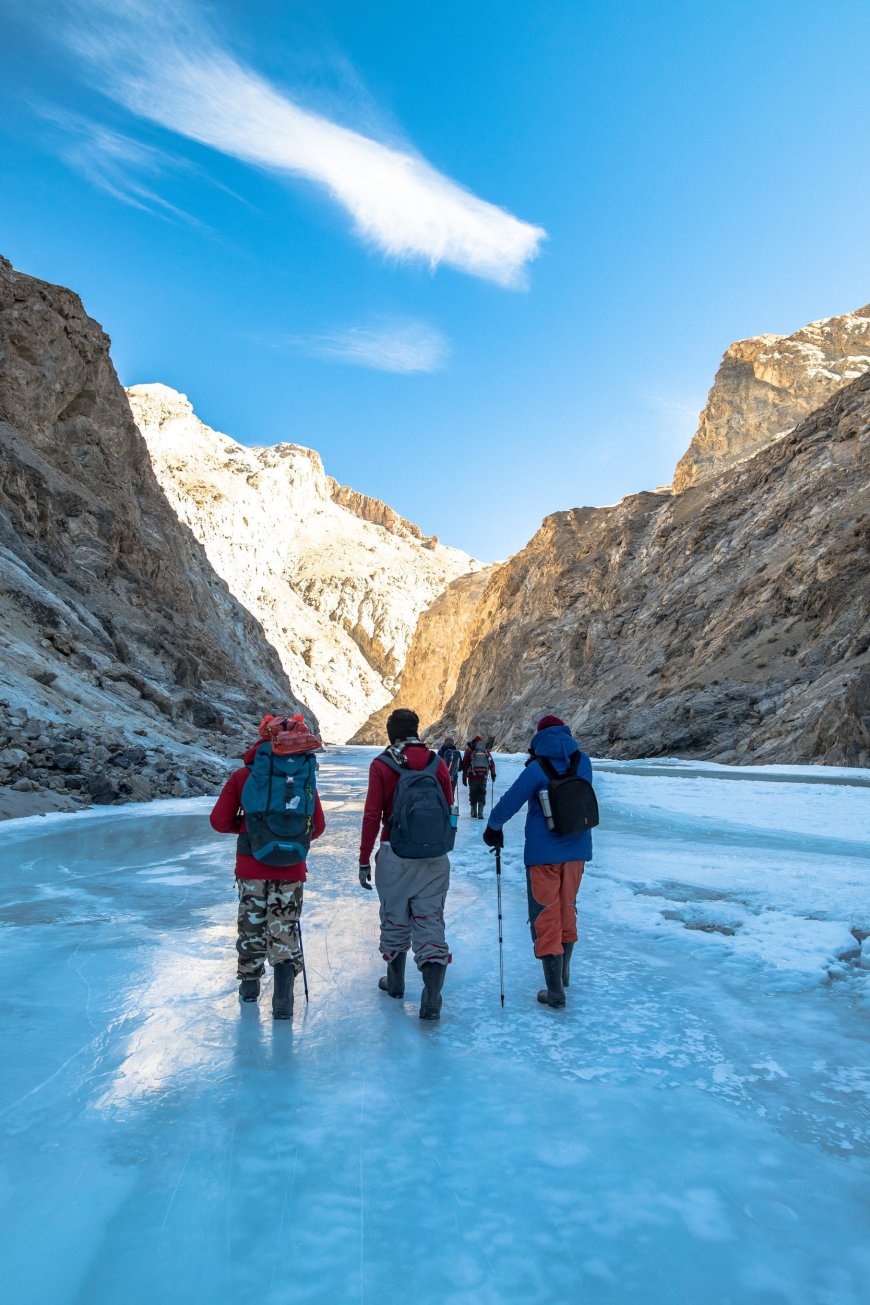Fitness and Training Tips for the Chadar Trek
The Chadar Trek in Ladakh is one of the most exhilarating and challenging treks in India. Taking place on the frozen Zanskar River, the trek offers stunning landscapes, unique experiences, and a test of endurance.

The Chadar Trek in Ladakh is one of the most exhilarating and challenging treks in India. Taking place on the frozen Zanskar River, the trek offers stunning landscapes, unique experiences, and a test of endurance. To fully enjoy and successfully complete the Chadar Trek, it is essential to be well-prepared both physically and mentally. This article will provide comprehensive fitness and training tips to help you conquer the Chadar Trek Ladakh.
Understanding the Chadar Trek
Before diving into the fitness and training aspects, it is crucial to understand what the Chadar Trek entails. The trek spans about 105 kilometers and is typically completed in 8-9 days. Trekkers walk on a sheet of ice formed over the Zanskar River, with temperatures often plummeting to -30°C. The trail includes walking on uneven ice, navigating through narrow gorges, and dealing with extreme cold. This makes physical fitness and mental resilience paramount.
Fitness Requirements for the Chadar Trek
1. Cardiovascular Endurance
Cardiovascular endurance is vital for the Chadar Trek as it involves long hours of walking at high altitudes. Start your training with aerobic exercises like running, cycling, and swimming. Aim for at least 30-45 minutes of cardio exercises, five times a week. Gradually increase the duration and intensity as your endurance improves.
2. Strength Training
Strength training is essential to handle the weight of your backpack and to navigate the icy terrain. Focus on building strength in your legs, core, and upper body. Incorporate exercises like squats, lunges, deadlifts, planks, and push-ups into your routine. Train with weights to build muscle endurance, and aim for at least three strength training sessions per week.
3. Flexibility
Flexibility helps in avoiding injuries and maintaining balance on the slippery ice. Include stretching exercises and yoga in your training regimen. Focus on stretches that target your hamstrings, quadriceps, calves, and lower back. Yoga poses like the downward dog, warrior pose, and seated forward bend can enhance flexibility and core strength.
4. Balance and Stability
Walking on ice requires excellent balance and stability. Incorporate balance training exercises such as single-leg stands, heel-to-toe walks, and stability ball exercises. These exercises will help you develop the necessary proprioception and coordination for walking on the frozen river.
Training Schedule for the Chadar Trek
1. 3-6 Months Before the Trek
- Cardio: Start with moderate-intensity cardio workouts for 30 minutes, five times a week. Gradually increase to 45 minutes to an hour.
- Strength Training: Focus on full-body workouts thrice a week. Include exercises like squats, lunges, push-ups, and core workouts.
- Flexibility: Incorporate stretching and yoga sessions twice a week.
2. 2-3 Months Before the Trek
- Cardio: Increase the intensity and duration of your cardio workouts. Include interval training and long-distance runs.
- Strength Training: Continue with full-body workouts and increase the weight and intensity. Add exercises that mimic trekking movements, such as step-ups with weights.
- Flexibility: Maintain regular stretching and yoga sessions. Focus on dynamic stretches that improve range of motion.
3. 1 Month Before the Trek
- Cardio: Focus on endurance with longer runs, hikes, or cycling sessions. Aim for at least 1-2 hours of cardio, three to four times a week.
- Strength Training: Emphasize endurance and functional strength. Incorporate circuit training with minimal rest between exercises.
- Flexibility: Ensure daily stretching to keep muscles supple and prevent stiffness.
Acclimatization and High-Altitude Training
The Chadar Trek Ladakh takes place at high altitudes, where oxygen levels are lower. Acclimatization is crucial to avoid altitude sickness. If possible, plan short treks or hikes at high altitudes before the Chadar Trek. This will help your body adapt to the reduced oxygen levels. Additionally, practice breathing exercises to improve lung capacity and oxygen intake.
Mental Preparation
Mental resilience is as important as physical fitness. The Chadar Trek is demanding, and maintaining a positive mindset will help you overcome challenges. Practice meditation and mindfulness to enhance focus and mental strength. Visualize the trek and mentally prepare yourself for the cold, the long walks, and the rugged terrain.
Nutrition and Hydration
Proper nutrition and hydration play a vital role in your training and during the trek. Consume a balanced diet rich in proteins, carbohydrates, and healthy fats. Include foods that provide sustained energy, such as whole grains, nuts, and lean proteins. Stay hydrated by drinking plenty of water throughout your training period and during the trek. In the cold, you may not feel as thirsty, but it’s crucial to keep drinking fluids to avoid dehydration.
Gear and Equipment Training
Familiarize yourself with the gear and equipment you will be using during the trek. Practice walking with your backpack, ensuring it is comfortable and well-adjusted. Wear the trekking shoes you plan to use on the Chadar Trek to break them in and avoid blisters. Get accustomed to walking with crampons or microspikes if you plan to use them on the icy terrain.
Recovery and Rest
Adequate rest and recovery are essential parts of your training regimen. Ensure you get enough sleep to allow your body to repair and build muscle. Include rest days in your training schedule to prevent overtraining and injuries. Listen to your body and give it the time it needs to recover.
Final Tips
- Start Early: Begin your training at least six months before the trek to build the necessary endurance and strength.
- Consistency: Be consistent with your training. Regular workouts will yield better results than sporadic intense sessions.
- Seek Professional Guidance: If possible, consult a fitness trainer or a physiotherapist to tailor a training program specific to your needs and goals.
- Monitor Progress: Keep track of your progress and make adjustments to your training plan as needed.
- Stay Motivated: Keep your goal in mind and stay motivated. Training for the Chadar Trek Ladakh is challenging, but the reward of experiencing one of the most unique treks in the world is worth the effort.
Conclusion
The Chadar Trek in Ladakh is a once-in-a-lifetime adventure that requires thorough preparation and training. By focusing on cardiovascular endurance, strength training, flexibility, balance, and mental resilience, you can ensure that you are well-equipped to tackle the challenges of the trek. With proper planning, consistent training, and a positive mindset, you will be ready to conquer the frozen Zanskar River and create unforgettable memories. Embrace the journey, stay motivated, and enjoy the breathtaking beauty of the Chadar Trek Ladakh.
What's Your Reaction?
 Like
0
Like
0
 Dislike
0
Dislike
0
 Love
0
Love
0
 Funny
0
Funny
0
 Angry
0
Angry
0
 Sad
0
Sad
0
 Wow
0
Wow
0

















































